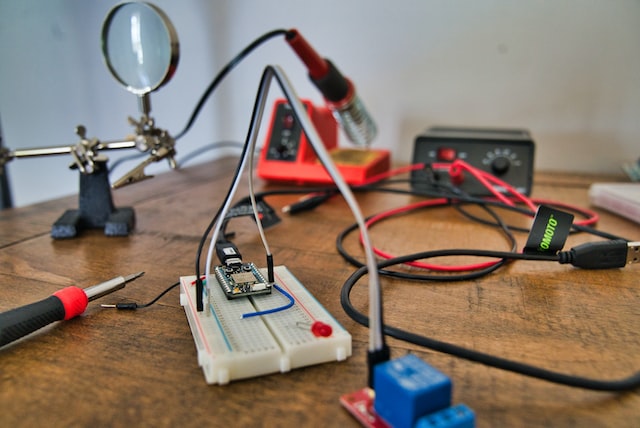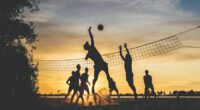Soldering is a process that involves melting a filler metal to join two pieces of metal, while welding is a process that involves melting the base metal itself to join two pieces of metal. Soldering is generally used for electronics and smaller-scale applications, while welding is used for larger-scale construction and manufacturing.
What is soldering?
(Photo by ThisisEngineering RAEng on Unsplash )

Soldering is a process where two pieces of metal are joined together by melting a filler metal and then cooling it so that it solidifies. This filler metal has a lower melting point than the base metals being joined, which allows it to flow into the joint and create a strong bond. Soldering is typically used for smaller projects or for delicate materials that can be damaged by heat.
What is welding?
(Photo by Christopher Burns on Unsplash )

Welding is a fabrication or sculptural process that joins materials, usually metals or thermoplastics, by causing coalescence. This is often done by melting the workpieces and adding a filler material to form a pool of molten material (the weld pool) that cools to form a joint that is usually stronger than the base material. Welding is distinct from lower temperature metal-joining techniques such as brazing and soldering, which do not melt the base metal.
The difference between soldering and welding
The main difference between soldering and welding is the temperatures that are used during each process. Soldering generally uses lower temperatures than welding, which means that soldering is often used for delicate electrical work, while welding is used for more heavy-duty projects.
In terms of the equipment needed for each process, soldering requires a soldering iron, while welding requires a welder. Both processes use some kind of filler material – in soldering, this is typically solder, while in welding it can be either wire or rod. The type of filler material will depend on the project you’re working on.
Welding also requires a power source, whereas soldering can be done with a battery-powered soldering iron. This makes welding more expensive and less portable than soldering. However, it also means that welding can handle tougher projects and bigger pieces of metal.
When to use soldering?
In general, soldering is used for joining together electrical components and wires. The main advantage of soldering over welding is that it can be done at lower temperatures, which means there is less risk of damaging the components. Soldering is also much easier to do than welding, so it is a good option for beginners.
There are two main types of soldering: Soft soldering and Hard soldering.
Soft soldering uses low melting point alloys, which makes it ideal for joining electrical components together.
Hard soldering uses high melting point alloys and is typically used for joining metal parts together.
When to use welding?
Welding is typically used when a permanent, strong, and durable joint is needed between two pieces of metal. It is often used in construction, manufacturing, and repair work where the joint needs to withstand high stress or pressure.
Welding is also commonly used when working with thicker pieces of metal or materials that are difficult to solder, such as aluminum, stainless steel, and cast iron. Additionally, welding can be used to create airtight and watertight seals, making it useful for applications such as pipelines, tanks, and ships.
Welding is a versatile and effective process for joining metal components and is often used in a wide range of industries and applications.
Is soldering as good as welding?
Welding and soldering are both methods of joining two pieces of metal together. Welding involves using heat to melt the metal, which is then cooled to create a strong bond. Soldering, on the other hand, uses a low-temperature melted alloy to join the pieces of metal. So, which method is better?
There are advantages and disadvantages to both welding and soldering. One advantage of welding is that it can be used on thicker pieces of metal. It is also a more permanent joint, so it is often used for structural applications. A disadvantage of welding is that it can distort the metal, and it requires special equipment and training.
Soldering, on the other hand, is less likely to distort the metal and can be done with simple equipment. However, soldered joints are not as strong as welded joints and are not suitable for structural applications.
So, which method is better? It really depends on the application. For most general applications, welding is the better choice. But for delicate projects or those where aesthetics are important, soldering may be the better option.
The advantages and disadvantages of welding?
Advantages of Welding:
- Strong and Durable Joints: Welding creates strong, permanent joints between metals that are able to withstand high stress and pressure, making it ideal for use in construction, manufacturing, and repair work.
- Versatility: Welding can be used to join a wide range of metals, including steel, aluminum, and stainless steel, as well as non-metallic materials such as plastics and composites.
- Efficiency: Welding can be a relatively quick and efficient process, allowing for the creation of complex structures and products in a shorter period of time than other joining methods.
- Precision: Welding can be highly precise and accurate, allowing for the creation of complex and intricate structures and products.
Disadvantages of Welding:
- High Cost: Welding equipment can be expensive, and the process itself can be time-consuming and labor-intensive, leading to higher costs for materials and labor.
- Safety Concerns: Welding can be a dangerous process, involving high heat, bright light, and potentially hazardous fumes and gases. Proper safety measures must be taken to protect welders and those nearby.
- Limited Portability: Welding equipment can be bulky and heavy, making it difficult to move and use in some locations.
- Distortion and Warping: The heat generated during welding can cause distortion and warping in the materials being joined, which can affect the overall quality and strength of the finished product.
While welding is a highly effective and versatile joining method, it does have some drawbacks and limitations that must be considered. Proper training, equipment, and safety measures are essential to ensure safe and effective welding processes.
The advantages and disadvantages of soldering?
Advantages of Soldering:
- Low Temperature: Soldering requires lower temperatures than welding, making it a more suitable option for joining materials that are sensitive to heat or cannot withstand high temperatures.
- Versatility: Soldering can be used to join a wide range of materials, including metals, ceramics, and plastics, making it a versatile joining method.
- Small Size: Soldering equipment is typically small and portable, making it easy to use in tight spaces and for small-scale projects.
- Clean Joints: Soldering produces clean and neat joints that do not require much post-processing or cleanup.
Disadvantages of Soldering:
- Weak Joints: Soldered joints are generally weaker than welded joints and may not be suitable for applications that require high strength or durability.
- Limited Strength: Soldering may not be suitable for joining heavy or load-bearing structures due to its limited strength.
- Limited Temperature Resistance: Soldered joints may not be able to withstand high temperatures, making it unsuitable for some applications.
- Skill and Training Required: Soldering requires a certain level of skill and training to produce reliable and strong joints, and improper technique can result in weak and unreliable joints.
While soldering is a useful and versatile joining method, it has some limitations, particularly in terms of joint strength and temperature resistance. Soldering is most commonly used in electronic and small-scale applications where its low heat and clean joints are advantageous.
Is soldering permanent?
Soldering can be a permanent joining method, but it depends on the materials being joined and the conditions the joint will be subjected to. Soldering creates a strong bond between the materials being joined, but it is not as strong as a welded joint.
In many electronic applications, soldered joints are considered permanent because they are strong enough to withstand the stresses of normal use and cannot be easily undone without damaging the components being joined. However, if the joint is subjected to extreme conditions such as high temperatures or heavy mechanical stress, the soldered joint may weaken or fail.
Additionally, some soldered joints may be designed to be temporary or easily removable, such as in plumbing applications where pipes may need to be disassembled and reassembled for maintenance or repair work.
Featured Image By – Photo by Clint Patterson on Unsplash








